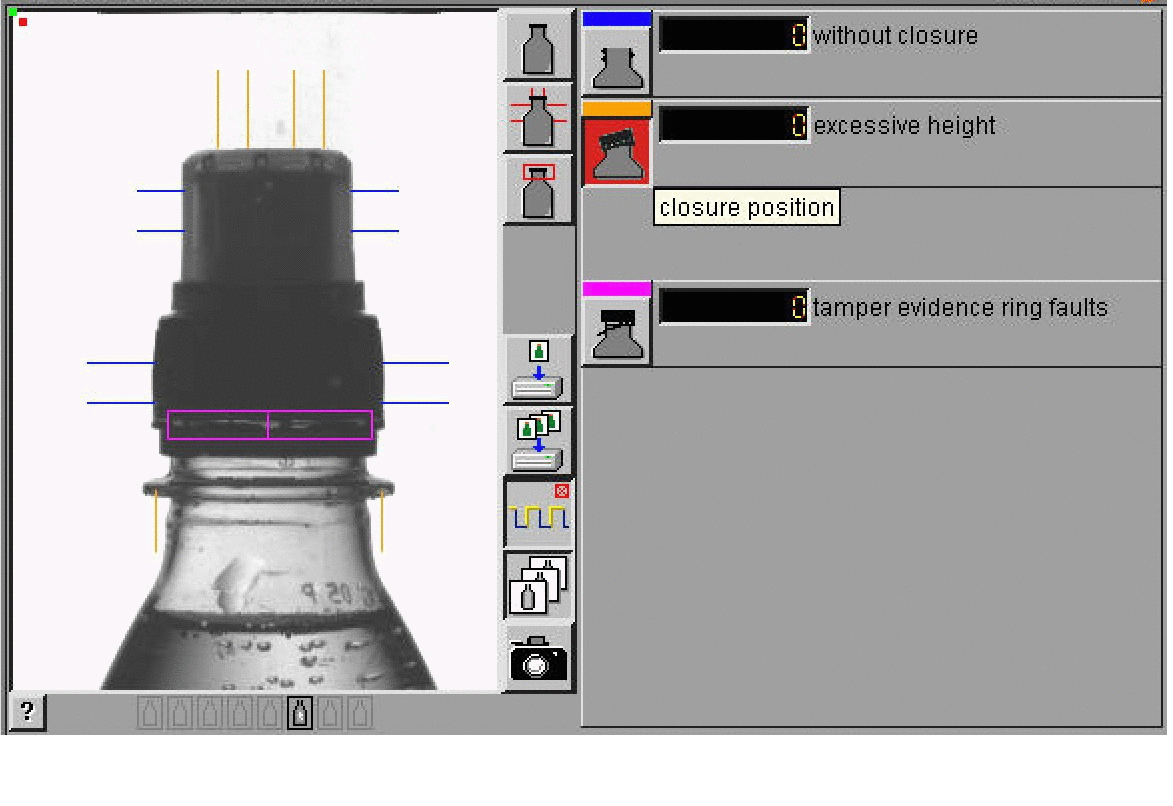The optic closure inspection is the most modern, comprehensive and satisfactory way to control closures’ status, its only disadvantages being cost and complexity, as seen by the user side.
It is devoted to detection of cocked (inclined) closures, broken TE (tamper evident) bands, closures applied too high or absent at all. All these factors implying contamination of the product and extremal risks for Consumers.
The basic operation principle implies a single CCD- or CMOS-camera, allowing a partial coverage, <180º, of the closure external lateral surface. The optic system includes 3 mirrors to increase the focal length, minimising optic aberrations due to parallax error.
The optic axe is centred on the neck ring. Single-camera equipped models cannot however prevent a bottle whose TE band is broken, from reaching the Consumer. 2-cameras systems are mandatory to prevent this occurrence.
A strobo flasher, today low-voltage model or IR LED matricial model, illuminates the bottle’ external sidewall, neck and closure. In case of low-voltage strobo flashes, em energy amounts to a few tens of joule, irradiated along approximately 0.1 m. With so short illumination times, also images of fast moving objects results crisp and frozen.

Broken Tamper Evident Rings, missing and inclined cap, cap too high or too low are the controls most commonly performed by mean visual cap camera systems
The VISION camera-equipped Final Container check, here in a PepsiCo® factory in the version with single camera vision system, in-the-Machine and featuring Advanced Sampling
Links to other Closure controls pages:
Crown-Cork, Threaded Cap or LidUltrasound Inner Pressure Inspection IntroductionIn these web pages we have frequently remarked the necessity to answer the fundamental question:…is it safe, can be sold that bottle?

  Broken Tamper Evident Rings, missing and inclined cap, cap too high or too low are the controls most commonly performed by mean visual cap camera systems Links to other Closure controls pages:…
Optic Closure Presence inspection, with analog photosensorsIntroductionThe optic closure inspection, with analog photosensor, is one of the simplest inspections existing. It adopts an analog photosensor, with a projector irradiating passing closures by the top and a receiver giving out to an operational amplifier a signal whose extension, the duration counted in encoder pulses, is proportional to the reflection. …
Laser check of Closure InclinationLinks to other pages about Closure Inspection:    The added value to apply a LASER slantedcap inspection to a Vision cap check Two different configurations exist for the LASER check of slanted caps:…

IntroductionThe simplest and cheapest way to check for the closing status of a container, where the closure is metallic, is the inductive-digital. The sensor is then an inductive one, its output an NPN polarity, on-off signal. …

Inner Pressure Inspectionby InductionOscillograms deriving by the induction analog measurements of two different lids. Each oscillogram composed by the sequence of hundredths of individual samplings operated by a single-channel analog sensor. …
Ultrasonic fobbing systemsWhy the ultrasonic fobbing systems ?Common disadvantages of the closure optic inspection systems: Optic, with 1, 2, or 3 CCD-camerasTamper evidence band Missing closure, inclined and high closure…

Caps' Colour InspectionTo perceive the rationale for the inspection of the Caps’ Colour, we recommended to see the video below. It has been filmed in a PepsiCo plant and in a beverage Bottling Line where, at the time of the film our staff commissioned twelve different formats, personalized by twelve different colours for the cap. …
- Ultrasound bottle and cap leakage inspection
- With 1 camera
- Optic closure check with 2 cameras
- Optic closure presence inspection, with analog photo scanner
- Slanted cap, with laser
- Inductive closure & lid inspection
- Inner Pressure Inspection with Analog Inductive sensors
- Ultrasonic fobbing systems
- Cap colour inspection
- Caps inspection and water drops
- Inclined cap, with LASER.pdf
Contact

